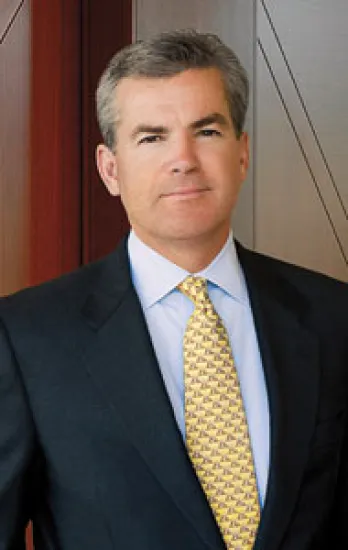When U.S. investors began to sour on American stocks in late 2007, fund managers were only too happy to lead them into more-buoyant overseas markets, and build up their own international business in the process. Then the collapse of Lehman Brothers Holdings spread financial panic around the world, hitting most international equities — particularly those of emerging markets — even harder than U.S. stocks.
Although the global sell-off nipped talk of decoupling in the bud, it hasn’t diminished the interest of U.S. asset managers in overseas markets.
Consider T. Rowe Price Group. In April the Baltimore-based fund manager eliminated 288 positions as part of a companywide initiative to reduce costs in the face of the market downturn. But only nine of those layoffs involved employees outside the U.S., because the firm regards foreign markets as key growth areas in the long term. Market declines drove the firm’s non-U.S. assets down 42 percent last year, to $39.92 billion, but some of that lost ground was regained in the first quarter, thanks in part to strong net inflows of $4.5 billion — most of which was channeled into non-U.S. strategies. "That snapped back very smartly," says Edward Bernard, the fund manager’s vice chairman in charge of marketing and distribution, noting that just over half the new money came from institutional investors. "The institutional business outside the U.S. is growing faster because we are underrepresented there."
Other leading fund management firms, including Capital Group Cos., Franklin Templeton Investments and Invesco, have maintained their international efforts even as they have cut back in the U.S. in recent months, executives say.
Barclays Global Investors, the world’s largest fund manager, has also seen a strong rebound in its international business. The San Francisco–based firm, which agreed to be acquired by BlackRock in June, attracted $92 billion in net inflows in the first five months of this year. BGI’s extensive global reach was one reason it was such an attractive acquisition target, according to BlackRock COO Susan Wagner.
"We did have very healthy flows into global mandates during the first handful of months this year," says BGI CEO Blake Grossman, although he declines to disclose the percentage of inflows allocated to non-U.S. strategies. Stronger performance helped draw investors, he says. For example, BGI’s International Tilts strategy, managed by Minder Cheng, the firm’s chief investment officer for active equities, outperformed the MSCI EAFE index by 17 basis points in 2008 after underperforming that benchmark for developed international markets by 277 basis points in 2007.
The recovery in international strategies is welcome news for U.S. fund managers. Foreign markets had been a major source of growth, and the firms were whipsawed by last year’s abrupt decline in those markets — and the investor withdrawals that ensued.
The MSCI EAFE index declined 45.1 percent in 2008, in dollar terms, a worse performance than that of the Standard & Poor’s 500 index, which was down 38.5 percent. Investors were spooked, triggering a net outflow of $60.43 billion from non-U.S. equity and fixed-income mutual funds and exchange-traded funds, according to Financial Research Corp. in Boston; billions more were withdrawn from separately managed accounts. It was a stark departure from the bounty of 2007, in which investors poured $229.37 billion into non-U.S. funds, according to FRC.
The 50 biggest U.S.-based managers of non-U.S. stocks and bonds, which make up Institutional Investor ’s annual ranking of America’s Largest Overseas Investors, saw combined foreign holdings fall by 38.6 percent last year, to $4.79 trillion. The robust growth rates of 21.9 percent in 2007 and 29.6 percent in 2006 were a distant memory.
BGI, which has placed No. 1 on the list every year since 2000, fared better than most of its rivals in 2008, with its global assets falling by 27.3 percent, to $728.84 billion. Those holdings accounted for 47.6 percent of BGI’s total assets, roughly the same share as in the previous year.
Other firms were less fortunate, particularly in global equities. State Street Global Advisors, which stays at No. 2, saw its non-U.S. assets fall 33.7 percent, to $439.12 billion. That represented 30.5 percent of the Boston-based firm’s total assets under management, or 3.1 percentage points less than a year earlier. The pressure point for SSgA was non-U.S. equities, where assets plummeted by 39.6 percent, to $328.53 billion. "Active equity has been an area where we have seen outflows," says SSgA CEO Scott Powers. Non-U.S. fixed-income assets fell only 6.9 percent, to $110.58 billion, as a new management team made improvements to SSgA’s active fixed-income investment processes, says Mark Marinella, executive visce president and global fixed-income CIO of SSgA.
Franklin Templeton Investments, which repeats at No. 7, suffered a fall in equity assets but enjoyed an increase in fixed-income assets outside the U.S. The San Mateo, California–based firm’s total non-U.S. assets fell by 39.7 percent, to $197.84 billion, mainly reflecting lower valuations as opposed to outflows. Its non-U.S. fixed-income assets rose by 17.6 percent, to $54.65 billion, boosted by strong net flows into its mainstay, institutional Global Fixed Income strategy.
Emerging markets have rebounded strongly in the first half of this year, but it could take some time before many U.S. investors that bailed out of those markets venture back in. "The U.S. investor hasn’t seen anything like this kind of decline," says Gregory Johnson, CEO of Franklin Templeton. "That’s a big concern: Is the trust still there?"
Johnson is betting that it is. In February and March this year, Franklin opened new country offices in Malaysia and Mexico, acquired a stake in an asset manager in Vietnam and increased an existing stake in an asset management firm in Dubai.






